HVAC Services Market Size 2025-2029
The hvac services market size is valued to increase USD 46.04 billion, at a CAGR of 8.8% from 2024 to 2029. Rapidly growing surface temperature will drive the hvac services market.
Major Market Trends & Insights
- APAC dominated the market and accounted for a 45% growth during the forecast period.
- By Service Type - Air conditioning services segment was valued at USD 35.94 billion in 2023
- By End-user - Non-residential segment accounted for the largest market revenue share in 2023
Market Size & Forecast
- Market Opportunities: USD 87.92 million
- Market Future Opportunities: USD 46036.80 million
- CAGR : 8.8%
- APAC: Largest market in 2023
Market Summary
- The market encompasses a dynamic and ever-evolving industry, driven by advancements in core technologies and applications. Rapidly growing sectors include the adoption of surface temperature advanced monitoring systems and intelligent technologies, which are transforming the way businesses and households manage their climate control needs. These innovations offer significant opportunities for market growth, yet face challenges from fluctuating prices of HVAC system raw materials. With the increasing demand for energy efficiency and sustainability, service types such as maintenance, repair, and installation continue to be in high demand.
- According to recent reports, The market is expected to account for over 50% of the total HVAC market share by 2025. This underscores the importance of staying informed about the latest trends and developments in this continuously evolving sector.
What will be the Size of the HVAC Services Market during the forecast period?
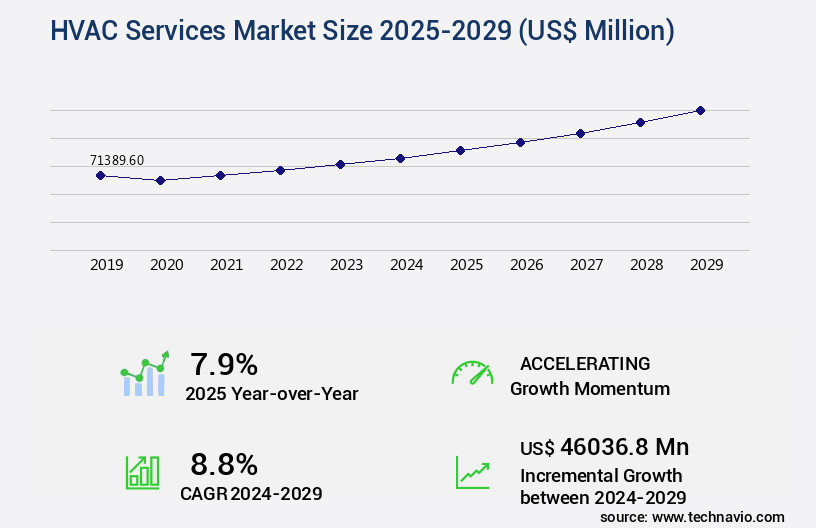
Get Key Insights on Market Forecast (PDF) Request Free Sample
How is the HVAC Services Market Segmented and what are the key trends of market segmentation?
The hvac services industry research report provides comprehensive data (region-wise segment analysis), with forecasts and estimates in "USD million" for the period 2025-2029, as well as historical data from 2019-2023 for the following segments.
- Service Type
- Air conditioning services
- Heating services
- Ventilation services
- End-user
- Non-residential
- Residential
- Distribution Channel
- Geography
- North America
- Europe
- APAC
- China
- India
- Japan
- South Korea
- Rest of World (ROW)
By Service Type Insights
The air conditioning services segment is estimated to witness significant growth during the forecast period.
Air conditioning systems have become an essential component of modern indoor spaces, with their application extending to various sectors including residential, commercial, and industrial buildings. The global market for HVAC services is experiencing significant growth due to the increasing demand for energy-efficient solutions, integration of building automation systems, and the expanding construction industry. Energy efficiency ratings play a crucial role in the selection of HVAC systems, with building energy modeling and thermal comfort standards guiding the design process. Humidity control systems, cooling system efficiency, and preventive maintenance schedules are essential considerations for maintaining optimal indoor environments. Heating system capacity and HVAC system upgrades are key areas of focus for businesses seeking to improve energy efficiency and reduce operational costs.
Air filtration systems, chilled water systems, and smart HVAC controls are increasingly popular solutions for enhancing indoor air quality and optimizing energy usage. The market for HVAC services is expected to grow substantially in the coming years, with a significant increase in demand from emerging markets. Preventive maintenance schedules, heat pump technology, and airflow optimization techniques are some of the trends driving this growth. Maintenance contract options and the HVAC equipment lifecycle are important factors influencing market dynamics. Thermal insulation materials, refrigeration cycle analysis, commissioning and testing, boiler system maintenance, energy monitoring software, and variable refrigerant flow are some of the key areas of innovation in the HVAC industry.
Retrofit projects, ductwork design standards, refrigerant charge calculations, air quality monitoring, and demand-controlled ventilation are also gaining traction as businesses seek to optimize their HVAC systems and reduce energy consumption. According to recent market research, The market is projected to grow by 15% in the next three years. Additionally, the market for building automation systems is expected to expand by 20% during the same period. These trends reflect the ongoing evolution of the HVAC industry and the increasing importance of energy efficiency and indoor environmental quality in modern buildings.
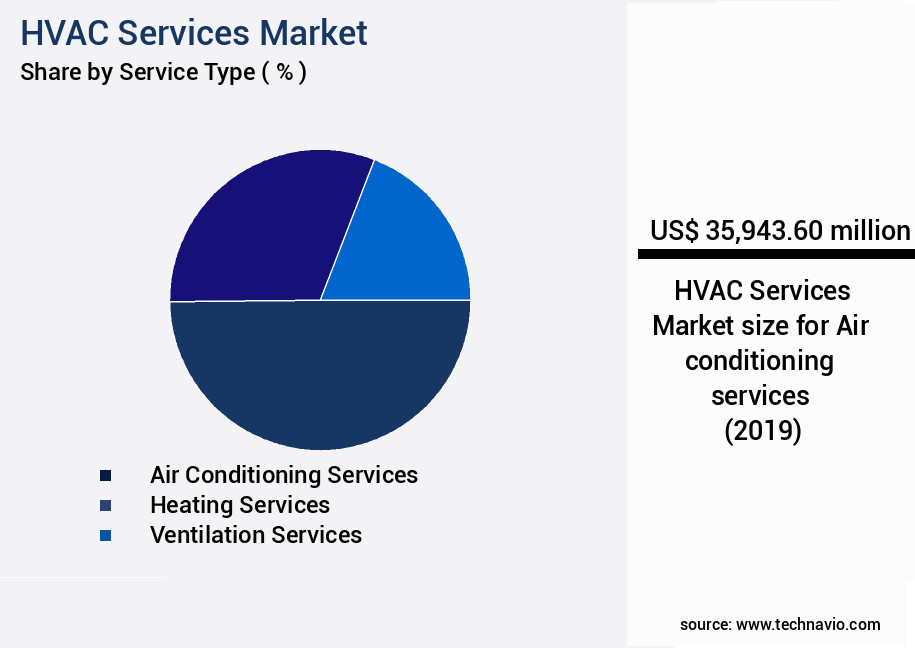
Request Free Sample
The Air conditioning services segment was valued at USD 35.94 billion in 2019 and showed a gradual increase during the forecast period.
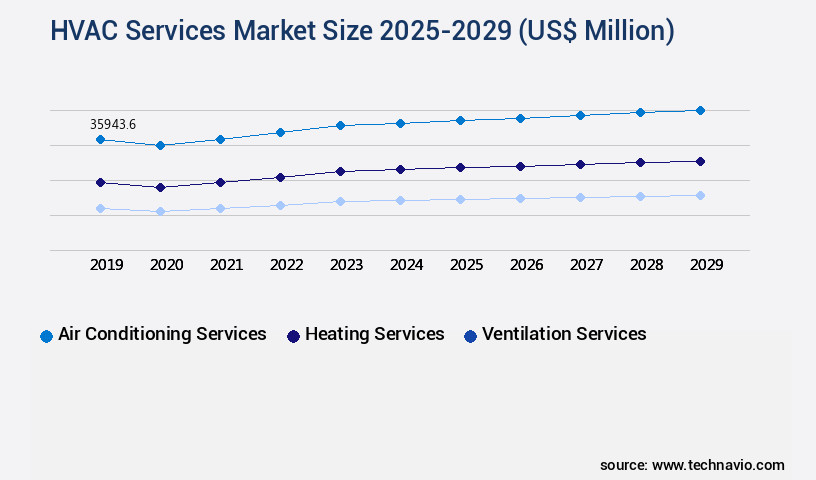
Request Free Sample
Regional Analysis
APAC is estimated to contribute 45% to the growth of the global market during the forecast period.Technavio's analysts have elaborately explained the regional trends and drivers that shape the market during the forecast period.
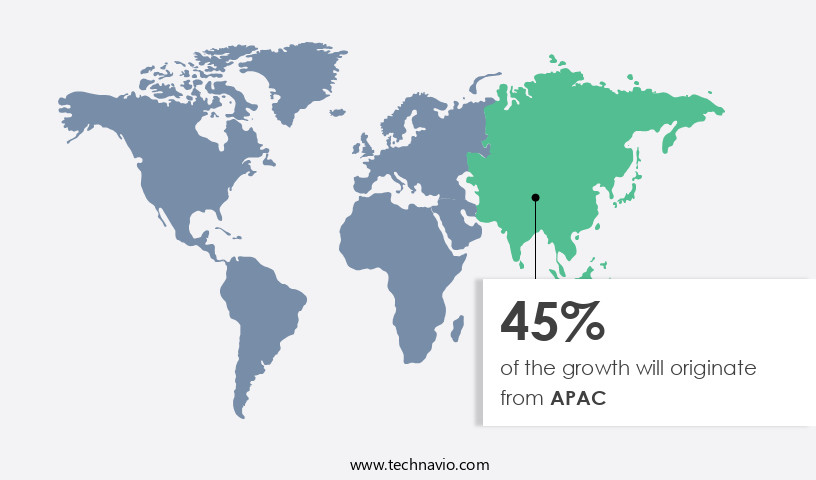
See How HVAC Services Market Demand is Rising in APAC Request Free Sample
The market in APAC is experiencing significant expansion due to population growth, extreme climatic conditions, and increasing urbanization. The construction sector's rise, particularly in commercial and residential projects, fuels the demand for HVAC systems. Energy-efficient HVAC systems are gaining popularity in the region due to green building initiatives in countries like China and India. Additionally, substantial investments in the real estate sector further propel the market's growth.
The APAC the market's dynamics are continuously evolving, with the adoption of advanced technologies and increasing focus on energy efficiency shaping future trends.
Market Dynamics
Our researchers analyzed the data with 2024 as the base year, along with the key drivers, trends, and challenges. A holistic analysis of drivers will help companies refine their marketing strategies to gain a competitive advantage.
The global HVAC systems market continues to evolve as organizations adopt strategies that balance performance, sustainability, and cost efficiency. Selecting the optimal HVAC system configuration for commercial buildings is becoming increasingly important as it directly impacts energy consumption, indoor air quality, and overall building operation costs. Reducing energy consumption in HVAC systems through advanced control technologies and data-driven optimization is central to lowering greenhouse gas emissions while meeting global efficiency standards.
Market research indicates that implementing energy-efficient HVAC technologies can cut operating expenses by as much as 25% compared to conventional systems. HVAC system retrofits for improved energy efficiency, combined with HVAC system design for LEED certification, are driving greater adoption across commercial facilities. Efficient refrigerant management practices further support sustainability goals, while strategies for enhancing HVAC system reliability ensure consistent performance in mission-critical environments.
To achieve long-term value, building operators are focusing on HVAC system maintenance for extended lifespan and techniques for minimizing HVAC system downtime. Implementing preventative maintenance programs enables proactive management of components, reducing unexpected failures and managing HVAC maintenance costs effectively. Calculating HVAC system return on investment using performance data highlights how advanced HVAC control system implementation and improving HVAC system response time contribute to optimized outcomes. By ensuring HVAC system compliance with building codes and adopting continuous monitoring, the market is aligning toward smarter, cleaner, and more reliable climate control solutions that enhance both environmental and economic performance.
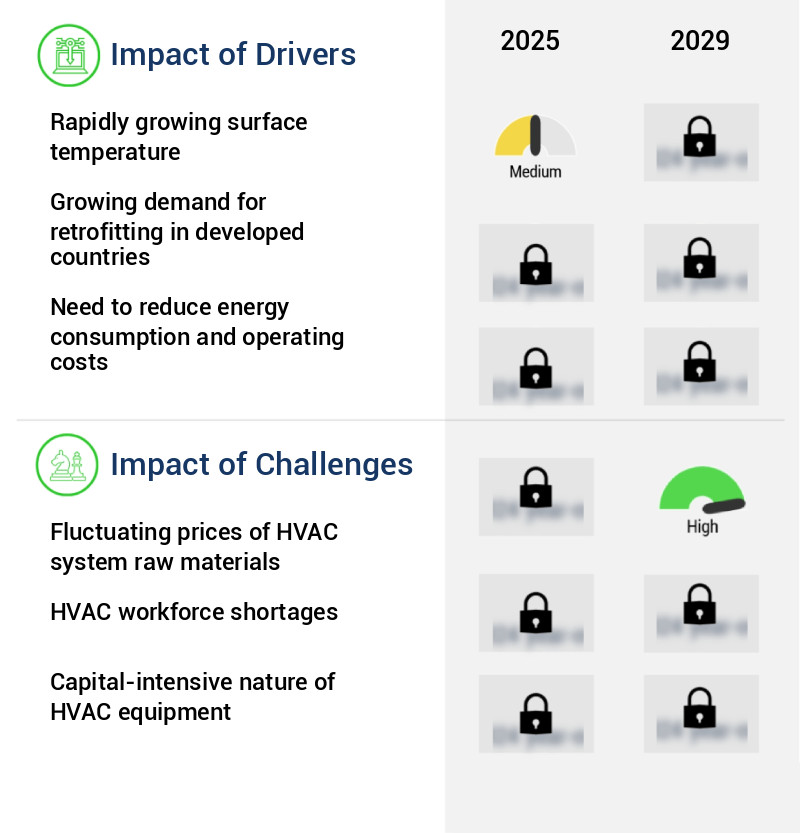
What are the key market drivers leading to the rise in the adoption of HVAC Services Industry?
- The rapid increase in surface temperature serves as the primary driver for the market's growth.
- The market is experiencing a significant shift due to the increasing surface temperatures around the world, driven by climate change. This trend is leading to increased demand for cooling systems in both residential and commercial sectors, particularly in regions that were previously considered temperate. As a result, HVAC service providers are expanding their capacity, improving system efficiency, and incorporating sustainable technologies to meet evolving consumer expectations and regulatory requirements.
- High-efficiency heat pumps, solar-powered HVAC units, and smart thermostats are gaining popularity as energy-efficient solutions to address escalating utility costs and environmental concerns. This ongoing evolution in the market reflects the continuous adaptation to changing climate patterns and consumer needs.
What are the market trends shaping the HVAC Services Industry?
- Advanced monitoring systems and intelligent technologies are becoming the market trend. Advanced monitoring systems and intelligent technologies are gaining popularity in various industries.
- Intelligent technologies and monitoring systems are revolutionizing The market. These innovations enable HVAC systems to regulate energy output effectively, while monitoring devices measure building energy consumption. The HVAC industry is capitalizing on the Internet of Things (IoT) integration to generate new revenue streams. The commercial building sector is expected to be an early adopter of this technology. IoT connects network-enabled devices to the Internet, facilitating data exchange. Although the adoption of IoT is still in its infancy, it offers significant potential for the HVAC industry.
- By leveraging IoT, HVAC systems can optimize energy usage, reduce operational costs, and enhance overall system performance. The integration of intelligent technologies and monitoring systems in HVAC services is a game-changer, transforming the industry landscape and opening up new opportunities for growth.
What challenges does the HVAC Services Industry face during its growth?
- The HVAC industry faces significant growth challenges due to the volatile pricing of its raw materials.
- The market experiences significant fluctuations due to the impact of raw material prices. Stainless steel, iron, bronze, and copper are essential components in HVAC equipment manufacturing. The prices of these materials are influenced by factors such as inflation, production levels, and supply. For instance, a 10% increase in the price of stainless steel could lead to a corresponding rise in the cost of HVAC equipment production. Small HVAC companies, unable to enter long-term contracts with suppliers, are more vulnerable to these price changes. Consequently, they face challenges in maintaining profitability and competitiveness. According to recent data, The market size was valued at USD200 billion in 2020, with a year-on-year growth rate of approximately 5%.
- Despite this growth, the market remains dynamic, with ongoing shifts in raw material prices and production costs affecting market trends. In summary, the market is influenced by the price volatility of key raw materials. Companies that can effectively manage these price fluctuations through strategic supplier relationships and operational flexibility are better positioned to succeed in this evolving market.
Exclusive Customer Landscape
The hvac services market forecasting report includes the adoption lifecycle of the market, covering from the innovator's stage to the laggard's stage. It focuses on adoption rates in different regions based on penetration. Furthermore, the hvac services market report also includes key purchase criteria and drivers of price sensitivity to help companies evaluate and develop their market growth analysis strategies.
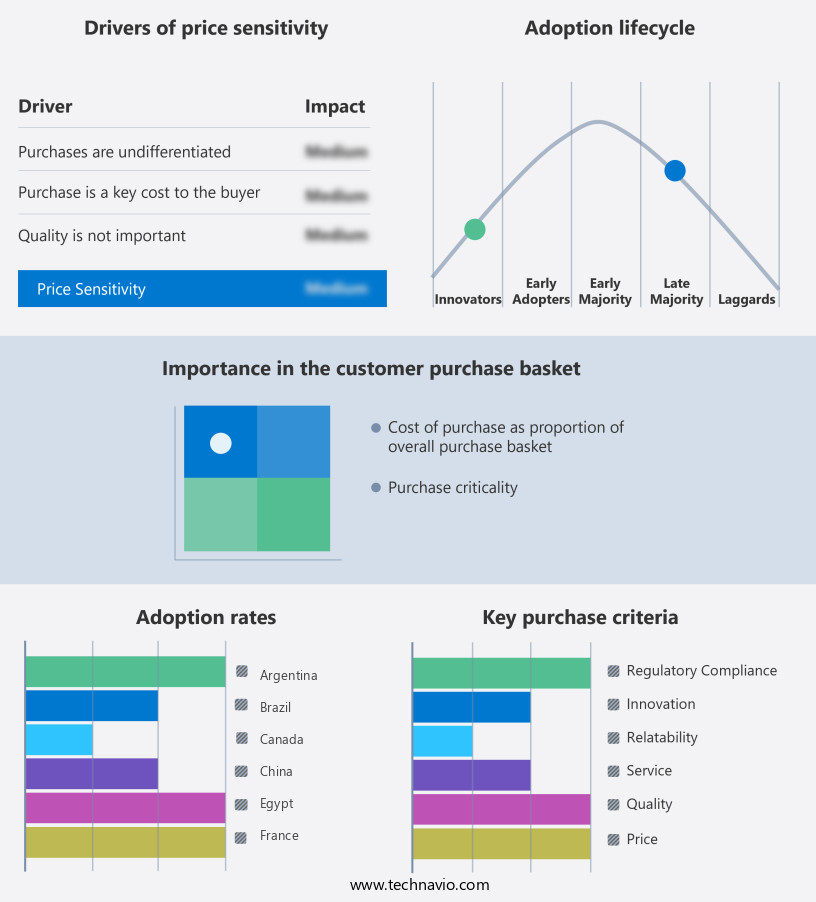
Customer Landscape of HVAC Services Industry
Competitive Landscape & Market Insights
Companies are implementing various strategies, such as strategic alliances, hvac services market forecast, partnerships, mergers and acquisitions, geographical expansion, and product/service launches, to enhance their presence in the industry.
ABM Industries Inc. - This company specializes in providing HVAC services, including preventative testing and commissioning, ensuring optimal system performance and energy efficiency for various industries. Their expertise lies in enhancing indoor environments through comprehensive maintenance solutions.
The industry research and growth report includes detailed analyses of the competitive landscape of the market and information about key companies, including:
- ABM Industries Inc.
- Air Comfort
- Alexander Mechanical Inc.
- Blue Star Ltd.
- Carrier Global Corp.
- Daikin Industries Ltd.
- EMCOR Group Inc.
- Emerson Electric Co.
- ENGIE SA
- Ferguson plc
- Fujitsu General Ltd.
- Ingersoll Rand Inc.
- J and J Air Conditioning
- Johnson Controls International Plc
- Lennox International Inc.
- LG Electronics Inc.
- Nortek
- Samsung Electronics Co. Ltd.
- Service Logic
- Siemens AG
Qualitative and quantitative analysis of companies has been conducted to help clients understand the wider business environment as well as the strengths and weaknesses of key industry players. Data is qualitatively analyzed to categorize companies as pure play, category-focused, industry-focused, and diversified; it is quantitatively analyzed to categorize companies as dominant, leading, strong, tentative, and weak.
Recent Development and News in HVAC Services Market
- In January 2024, Carrier Global Corporation, a leading HVAC manufacturer, announced the launch of its new line of energy-efficient air conditioning units, the AquaEdge 19DV centrifugal chiller, at the AHR Expo (Source: Carrier Global Corporation Press Release). This innovative product is designed to reduce energy consumption by up to 10% compared to previous models.
- In March 2024, Johnson Controls, another major player in the HVAC market, entered into a strategic partnership with Google to integrate its OpenBlue digital platform with Google's Building IoT (Source: Johnson Controls Press Release). This collaboration aims to enhance energy efficiency and optimize building operations using advanced analytics and machine learning.
- In May 2024, United Technologies Corporation completed the acquisition of Honeywell International's Home and Building Technologies business, significantly expanding its presence in the market (Source: United Technologies Corporation Press Release). The acquisition added approximately USD7.8 billion in revenue to United Technologies' portfolio.
- In February 2025, the European Union passed the revised Energy Performance of Buildings Directive (EPBD), mandating stricter energy efficiency standards for new and existing buildings (Source: European Parliament Press Release). This policy change is expected to drive demand for energy-efficient HVAC systems in Europe.
Dive into Technavio's robust research methodology, blending expert interviews, extensive data synthesis, and validated models for unparalleled HVAC Services Market insights. See full methodology.
|
Market Scope
|
|
Report Coverage
|
Details
|
|
Page number
|
223
|
|
Base year
|
2024
|
|
Historic period
|
2019-2023 |
|
Forecast period
|
2025-2029
|
|
Growth momentum & CAGR
|
Accelerate at a CAGR of 8.8%
|
|
Market growth 2025-2029
|
USD 46036.8 million
|
|
Market structure
|
Fragmented
|
|
YoY growth 2024-2025(%)
|
7.9
|
|
Key countries
|
US, China, Japan, India, Germany, South Korea, UK, Canada, France, and Italy
|
|
Competitive landscape
|
Leading Companies, Market Positioning of Companies, Competitive Strategies, and Industry Risks
|
Request Free Sample
Research Analyst Overview
- In the dynamic and evolving realm of HVAC services, energy efficiency ratings have emerged as a significant driving force. Building automation systems, which integrate HVAC components with other building systems, are increasingly adopted to optimize energy usage. Building energy modeling, a crucial aspect of design, enables the prediction and analysis of energy consumption patterns. Humidity control systems ensure thermal comfort by maintaining optimal indoor conditions, while troubleshooting HVAC issues is essential for maintaining cooling system efficiency. Preventive maintenance schedules, a proactive approach, help extend heating system capacity and reduce downtime. HVAC system upgrades, incorporating advanced technologies like air filtration systems and chilled water systems, enhance overall performance.
- Smart HVAC controls, such as thermal comfort standards and airflow optimization techniques, facilitate energy savings and improved indoor air quality. Variable refrigerant flow and demand-controlled ventilation systems adapt to changing conditions, further increasing efficiency. Maintenance contract options offer peace of mind, ensuring professional upkeep of HVAC equipment throughout its lifecycle. Thermal insulation materials, a critical component in HVAC design, reduce energy loss and improve system efficiency. Refrigeration cycle analysis and commissioning and testing are essential steps in ensuring optimal HVAC performance. Boiler system maintenance and energy monitoring software further enhance efficiency and cost savings. Retrofit projects, incorporating heat pump technology and ductwork design standards, transform older systems into energy-efficient powerhouses.
- Refrigerant charge calculations and air quality monitoring are integral to maintaining system health and performance. Overall, the market continues to evolve, with a focus on energy efficiency, advanced technologies, and proactive maintenance strategies.
What are the Key Data Covered in this HVAC Services Market Research and Growth Report?
-
What is the expected growth of the HVAC Services Market between 2025 and 2029?
-
What segmentation does the market report cover?
-
The report segmented by Service Type (Air conditioning services, Heating services, and Ventilation services), End-user (Non-residential and Residential), Distribution Channel (Online and Offline), and Geography (APAC, North America, Europe, Middle East and Africa, and South America)
-
Which regions are analyzed in the report?
-
APAC, North America, Europe, Middle East and Africa, and South America
-
What are the key growth drivers and market challenges?
-
Who are the major players in the HVAC Services Market?
-
Key Companies ABM Industries Inc., Air Comfort, Alexander Mechanical Inc., Blue Star Ltd., Carrier Global Corp., Daikin Industries Ltd., EMCOR Group Inc., Emerson Electric Co., ENGIE SA, Ferguson plc, Fujitsu General Ltd., Ingersoll Rand Inc., J and J Air Conditioning, Johnson Controls International Plc, Lennox International Inc., LG Electronics Inc., Nortek, Samsung Electronics Co. Ltd., Service Logic, and Siemens AG
Market Research Insights
- The market encompasses a diverse range of offerings, from system design and installation to maintenance, repair, and optimization. According to industry estimates, the global HVAC market size was valued at USD203.4 billion in 2020 and is projected to expand at a steady rate, driven by the increasing demand for energy efficiency and sustainability. One key trend shaping the market is the integration of advanced technologies, such as system redundancy design, remote monitoring capabilities, and duct sealing techniques, to enhance performance and reduce energy consumption. For instance, the adoption of sensors and data acquisition systems enables real-time monitoring and analysis of system performance, leading to improved energy savings and occupant comfort.
- Moreover, the growing emphasis on sustainability certifications and compliance regulations is driving the market's evolution, with companies focusing on thermal bridging reduction, refrigerant leak detection, and air pressure balancing to minimize environmental impact. Performance benchmarking data and occupant comfort surveys are essential tools for assessing the effectiveness of these measures and optimizing system design and maintenance strategies accordingly. In contrast, non-compliance with safety regulations and inadequate maintenance can lead to significant costs, including parts replacement, emergency shutdown procedures, and potential damage to indoor environmental quality. Effective maintenance log records and infiltration control measures are crucial for minimizing these risks and ensuring long-term system reliability.
- Overall, the market is characterized by continuous innovation and a focus on energy efficiency, sustainability, and regulatory compliance. By leveraging advanced technologies and best practices, companies can deliver high-performing, cost-effective, and environmentally responsible HVAC solutions for buildings of all sizes and types.
We can help! Our analysts can customize this hvac services market research report to meet your requirements.
Get in touch
1 Executive Summary
- 1.1 Market overview
- Executive Summary - Chart on Market Overview
- Executive Summary - Data Table on Market Overview
- Executive Summary - Chart on Global Market Characteristics
- Executive Summary - Chart on Market by Geography
- Executive Summary - Chart on Market Segmentation by Service Type
- Executive Summary - Chart on Market Segmentation by End-user
- Executive Summary - Chart on Market Segmentation by Distribution Channel
- Executive Summary - Chart on Incremental Growth
- Executive Summary - Data Table on Incremental Growth
- Executive Summary - Chart on Company Market Positioning
2 Technavio Analysis
- 2.1 Analysis of price sensitivity, lifecycle, customer purchase basket, adoption rates, and purchase criteria
- Analysis of price sensitivity, lifecycle, customer purchase basket, adoption rates, and purchase criteria
- 2.2 Criticality of inputs and Factors of differentiation
- Overview on criticality of inputs and factors of differentiation
- 2.3 Factors of disruption
- Overview on factors of disruption
- 2.4 Impact of drivers and challenges
- Impact of drivers and challenges in 2024 and 2029
3 Market Landscape
- 3.1 Market ecosystem
- Parent Market
- Data Table on - Parent Market
- 3.2 Market characteristics
- Market characteristics analysis
4 Market Sizing
- 4.1 Market definition
- Offerings of companies included in the market definition
- 4.2 Market segment analysis
- 4.4 Market outlook: Forecast for 2024-2029
- Chart on Global - Market size and forecast 2024-2029 ($ million)
- Data Table on Global - Market size and forecast 2024-2029 ($ million)
- Chart on Global Market: Year-over-year growth 2024-2029 (%)
- Data Table on Global Market: Year-over-year growth 2024-2029 (%)
5 Historic Market Size
- 5.1 Global HVAC Services Market 2019 - 2023
- Historic Market Size - Data Table on Global HVAC Services Market 2019 - 2023 ($ million)
- 5.2 Service Type segment analysis 2019 - 2023
- Historic Market Size - Service Type Segment 2019 - 2023 ($ million)
- 5.3 End-user segment analysis 2019 - 2023
- Historic Market Size - End-user Segment 2019 - 2023 ($ million)
- 5.4 Distribution Channel segment analysis 2019 - 2023
- Historic Market Size - Distribution Channel Segment 2019 - 2023 ($ million)
- 5.5 Geography segment analysis 2019 - 2023
- Historic Market Size - Geography Segment 2019 - 2023 ($ million)
- 5.6 Country segment analysis 2019 - 2023
- Historic Market Size - Country Segment 2019 - 2023 ($ million)
6 Qualitative Analysis
- 6.1 The AI impact on Global HVAC services Market
7 Five Forces Analysis
- 7.1 Five forces summary
- Five forces analysis - Comparison between 2024 and 2029
- 7.2 Bargaining power of buyers
- Bargaining power of buyers - Impact of key factors 2024 and 2029
- 7.3 Bargaining power of suppliers
- Bargaining power of suppliers - Impact of key factors in 2024 and 2029
- 7.4 Threat of new entrants
- Threat of new entrants - Impact of key factors in 2024 and 2029
- 7.5 Threat of substitutes
- Threat of substitutes - Impact of key factors in 2024 and 2029
- 7.6 Threat of rivalry
- Threat of rivalry - Impact of key factors in 2024 and 2029
- 7.7 Market condition
- Chart on Market condition - Five forces 2024 and 2029
8 Market Segmentation by Service Type
- 8.1 Market segments
- Chart on Service Type - Market share 2024-2029 (%)
- Data Table on Service Type - Market share 2024-2029 (%)
- 8.2 Comparison by Service Type
- Chart on Comparison by Service Type
- Data Table on Comparison by Service Type
- 8.3 Air conditioning services - Market size and forecast 2024-2029
- Chart on Air conditioning services - Market size and forecast 2024-2029 ($ million)
- Data Table on Air conditioning services - Market size and forecast 2024-2029 ($ million)
- Chart on Air conditioning services - Year-over-year growth 2024-2029 (%)
- Data Table on Air conditioning services - Year-over-year growth 2024-2029 (%)
- 8.4 Heating services - Market size and forecast 2024-2029
- Chart on Heating services - Market size and forecast 2024-2029 ($ million)
- Data Table on Heating services - Market size and forecast 2024-2029 ($ million)
- Chart on Heating services - Year-over-year growth 2024-2029 (%)
- Data Table on Heating services - Year-over-year growth 2024-2029 (%)
- 8.5 Ventilation services - Market size and forecast 2024-2029
- Chart on Ventilation services - Market size and forecast 2024-2029 ($ million)
- Data Table on Ventilation services - Market size and forecast 2024-2029 ($ million)
- Chart on Ventilation services - Year-over-year growth 2024-2029 (%)
- Data Table on Ventilation services - Year-over-year growth 2024-2029 (%)
- 8.6 Market opportunity by Service Type
- Market opportunity by Service Type ($ million)
- Data Table on Market opportunity by Service Type ($ million)
9 Market Segmentation by End-user
- 9.1 Market segments
- Chart on End-user - Market share 2024-2029 (%)
- Data Table on End-user - Market share 2024-2029 (%)
- 9.2 Comparison by End-user
- Chart on Comparison by End-user
- Data Table on Comparison by End-user
- 9.3 Non-residential - Market size and forecast 2024-2029
- Chart on Non-residential - Market size and forecast 2024-2029 ($ million)
- Data Table on Non-residential - Market size and forecast 2024-2029 ($ million)
- Chart on Non-residential - Year-over-year growth 2024-2029 (%)
- Data Table on Non-residential - Year-over-year growth 2024-2029 (%)
- 9.4 Residential - Market size and forecast 2024-2029
- Chart on Residential - Market size and forecast 2024-2029 ($ million)
- Data Table on Residential - Market size and forecast 2024-2029 ($ million)
- Chart on Residential - Year-over-year growth 2024-2029 (%)
- Data Table on Residential - Year-over-year growth 2024-2029 (%)
- 9.5 Market opportunity by End-user
- Market opportunity by End-user ($ million)
- Data Table on Market opportunity by End-user ($ million)
10 Market Segmentation by Distribution Channel
- 10.1 Market segments
- Chart on Distribution Channel - Market share 2024-2029 (%)
- Data Table on Distribution Channel - Market share 2024-2029 (%)
- 10.2 Comparison by Distribution Channel
- Chart on Comparison by Distribution Channel
- Data Table on Comparison by Distribution Channel
- 10.3 Offline - Market size and forecast 2024-2029
- Chart on Offline - Market size and forecast 2024-2029 ($ million)
- Data Table on Offline - Market size and forecast 2024-2029 ($ million)
- Chart on Offline - Year-over-year growth 2024-2029 (%)
- Data Table on Offline - Year-over-year growth 2024-2029 (%)
- 10.4 Online - Market size and forecast 2024-2029
- Chart on Online - Market size and forecast 2024-2029 ($ million)
- Data Table on Online - Market size and forecast 2024-2029 ($ million)
- Chart on Online - Year-over-year growth 2024-2029 (%)
- Data Table on Online - Year-over-year growth 2024-2029 (%)
- 10.5 Market opportunity by Distribution Channel
- Market opportunity by Distribution Channel ($ million)
- Data Table on Market opportunity by Distribution Channel ($ million)
11 Customer Landscape
- 11.1 Customer landscape overview
- Analysis of price sensitivity, lifecycle, customer purchase basket, adoption rates, and purchase criteria
12 Geographic Landscape
- 12.1 Geographic segmentation
- Chart on Market share by geography 2024-2029 (%)
- Data Table on Market share by geography 2024-2029 (%)
- 12.2 Geographic comparison
- Chart on Geographic comparison
- Data Table on Geographic comparison
- 12.3 APAC - Market size and forecast 2024-2029
- Chart on APAC - Market size and forecast 2024-2029 ($ million)
- Data Table on APAC - Market size and forecast 2024-2029 ($ million)
- Chart on APAC - Year-over-year growth 2024-2029 (%)
- Data Table on APAC - Year-over-year growth 2024-2029 (%)
- 12.4 North America - Market size and forecast 2024-2029
- Chart on North America - Market size and forecast 2024-2029 ($ million)
- Data Table on North America - Market size and forecast 2024-2029 ($ million)
- Chart on North America - Year-over-year growth 2024-2029 (%)
- Data Table on North America - Year-over-year growth 2024-2029 (%)
- 12.5 Europe - Market size and forecast 2024-2029
- Chart on Europe - Market size and forecast 2024-2029 ($ million)
- Data Table on Europe - Market size and forecast 2024-2029 ($ million)
- Chart on Europe - Year-over-year growth 2024-2029 (%)
- Data Table on Europe - Year-over-year growth 2024-2029 (%)
- 12.6 Middle East and Africa - Market size and forecast 2024-2029
- Chart on Middle East and Africa - Market size and forecast 2024-2029 ($ million)
- Data Table on Middle East and Africa - Market size and forecast 2024-2029 ($ million)
- Chart on Middle East and Africa - Year-over-year growth 2024-2029 (%)
- Data Table on Middle East and Africa - Year-over-year growth 2024-2029 (%)
- 12.7 South America - Market size and forecast 2024-2029
- Chart on South America - Market size and forecast 2024-2029 ($ million)
- Data Table on South America - Market size and forecast 2024-2029 ($ million)
- Chart on South America - Year-over-year growth 2024-2029 (%)
- Data Table on South America - Year-over-year growth 2024-2029 (%)
- 12.8 US - Market size and forecast 2024-2029
- Chart on US - Market size and forecast 2024-2029 ($ million)
- Data Table on US - Market size and forecast 2024-2029 ($ million)
- Chart on US - Year-over-year growth 2024-2029 (%)
- Data Table on US - Year-over-year growth 2024-2029 (%)
- 12.9 China - Market size and forecast 2024-2029
- Chart on China - Market size and forecast 2024-2029 ($ million)
- Data Table on China - Market size and forecast 2024-2029 ($ million)
- Chart on China - Year-over-year growth 2024-2029 (%)
- Data Table on China - Year-over-year growth 2024-2029 (%)
- 12.10 Japan - Market size and forecast 2024-2029
- Chart on Japan - Market size and forecast 2024-2029 ($ million)
- Data Table on Japan - Market size and forecast 2024-2029 ($ million)
- Chart on Japan - Year-over-year growth 2024-2029 (%)
- Data Table on Japan - Year-over-year growth 2024-2029 (%)
- 12.11 India - Market size and forecast 2024-2029
- Chart on India - Market size and forecast 2024-2029 ($ million)
- Data Table on India - Market size and forecast 2024-2029 ($ million)
- Chart on India - Year-over-year growth 2024-2029 (%)
- Data Table on India - Year-over-year growth 2024-2029 (%)
- 12.12 Germany - Market size and forecast 2024-2029
- Chart on Germany - Market size and forecast 2024-2029 ($ million)
- Data Table on Germany - Market size and forecast 2024-2029 ($ million)
- Chart on Germany - Year-over-year growth 2024-2029 (%)
- Data Table on Germany - Year-over-year growth 2024-2029 (%)
- 12.13 Canada - Market size and forecast 2024-2029
- Chart on Canada - Market size and forecast 2024-2029 ($ million)
- Data Table on Canada - Market size and forecast 2024-2029 ($ million)
- Chart on Canada - Year-over-year growth 2024-2029 (%)
- Data Table on Canada - Year-over-year growth 2024-2029 (%)
- 12.14 South Korea - Market size and forecast 2024-2029
- Chart on South Korea - Market size and forecast 2024-2029 ($ million)
- Data Table on South Korea - Market size and forecast 2024-2029 ($ million)
- Chart on South Korea - Year-over-year growth 2024-2029 (%)
- Data Table on South Korea - Year-over-year growth 2024-2029 (%)
- 12.15 UK - Market size and forecast 2024-2029
- Chart on UK - Market size and forecast 2024-2029 ($ million)
- Data Table on UK - Market size and forecast 2024-2029 ($ million)
- Chart on UK - Year-over-year growth 2024-2029 (%)
- Data Table on UK - Year-over-year growth 2024-2029 (%)
- 12.16 France - Market size and forecast 2024-2029
- Chart on France - Market size and forecast 2024-2029 ($ million)
- Data Table on France - Market size and forecast 2024-2029 ($ million)
- Chart on France - Year-over-year growth 2024-2029 (%)
- Data Table on France - Year-over-year growth 2024-2029 (%)
- 12.17 Italy - Market size and forecast 2024-2029
- Chart on Italy - Market size and forecast 2024-2029 ($ million)
- Data Table on Italy - Market size and forecast 2024-2029 ($ million)
- Chart on Italy - Year-over-year growth 2024-2029 (%)
- Data Table on Italy - Year-over-year growth 2024-2029 (%)
- 12.18 Market opportunity by geography
- Market opportunity by geography ($ million)
- Data Tables on Market opportunity by geography ($ million)
13 Drivers, Challenges, and Opportunity/Restraints
- 13.3 Impact of drivers and challenges
- Impact of drivers and challenges in 2024 and 2029
- 13.4 Market opportunities/restraints
14 Competitive Landscape
- 14.2 Competitive Landscape
- Overview on criticality of inputs and factors of differentiation
- 14.3 Landscape disruption
- Overview on factors of disruption
- 14.4 Industry risks
- Impact of key risks on business
15 Competitive Analysis
- 15.2 Company ranking index
- 15.3 Market positioning of companies
- Matrix on companies position and classification
- 15.4 ABM Industries Inc.
- ABM Industries Inc. - Overview
- ABM Industries Inc. - Business segments
- ABM Industries Inc. - Key offerings
- ABM Industries Inc. - Segment focus
- SWOT
- 15.5 Air Comfort
- Air Comfort - Overview
- Air Comfort - Product / Service
- Air Comfort - Key offerings
- SWOT
- 15.6 Alexander Mechanical Inc.
- Alexander Mechanical Inc. - Overview
- Alexander Mechanical Inc. - Product / Service
- Alexander Mechanical Inc. - Key offerings
- SWOT
- 15.7 Blue Star Ltd.
- Blue Star Ltd. - Overview
- Blue Star Ltd. - Business segments
- Blue Star Ltd. - Key news
- Blue Star Ltd. - Key offerings
- Blue Star Ltd. - Segment focus
- SWOT
- 15.8 Carrier Global Corp.
- Carrier Global Corp. - Overview
- Carrier Global Corp. - Business segments
- Carrier Global Corp. - Key news
- Carrier Global Corp. - Key offerings
- Carrier Global Corp. - Segment focus
- SWOT
- 15.9 Daikin Industries Ltd.
- Daikin Industries Ltd. - Overview
- Daikin Industries Ltd. - Business segments
- Daikin Industries Ltd. - Key news
- Daikin Industries Ltd. - Key offerings
- Daikin Industries Ltd. - Segment focus
- SWOT
- 15.10 Emerson Electric Co.
- Emerson Electric Co. - Overview
- Emerson Electric Co. - Business segments
- Emerson Electric Co. - Key news
- Emerson Electric Co. - Key offerings
- Emerson Electric Co. - Segment focus
- SWOT
- 15.11 ENGIE SA
- ENGIE SA - Overview
- ENGIE SA - Business segments
- ENGIE SA - Key offerings
- ENGIE SA - Segment focus
- SWOT
- 15.12 Fujitsu General Ltd.
- Fujitsu General Ltd. - Overview
- Fujitsu General Ltd. - Product / Service
- Fujitsu General Ltd. - Key offerings
- SWOT
- 15.13 Ingersoll Rand Inc.
- Ingersoll Rand Inc. - Overview
- Ingersoll Rand Inc. - Business segments
- Ingersoll Rand Inc. - Key news
- Ingersoll Rand Inc. - Key offerings
- Ingersoll Rand Inc. - Segment focus
- SWOT
- 15.14 J and J Air Conditioning
- J and J Air Conditioning - Overview
- J and J Air Conditioning - Product / Service
- J and J Air Conditioning - Key offerings
- SWOT
- 15.15 Johnson Controls International Plc
- Johnson Controls International Plc - Overview
- Johnson Controls International Plc - Business segments
- Johnson Controls International Plc - Key news
- Johnson Controls International Plc - Key offerings
- Johnson Controls International Plc - Segment focus
- SWOT
- 15.16 Samsung Electronics Co. Ltd.
- Samsung Electronics Co. Ltd. - Overview
- Samsung Electronics Co. Ltd. - Business segments
- Samsung Electronics Co. Ltd. - Key news
- Samsung Electronics Co. Ltd. - Key offerings
- Samsung Electronics Co. Ltd. - Segment focus
- SWOT
- 15.17 Service Logic
- Service Logic - Overview
- Service Logic - Product / Service
- Service Logic - Key offerings
- SWOT
- 15.18 Siemens AG
- Siemens AG - Overview
- Siemens AG - Business segments
- Siemens AG - Key news
- Siemens AG - Key offerings
- Siemens AG - Segment focus
- SWOT
16 Appendix
- 16.2 Inclusions and exclusions checklist
- Inclusions checklist
- Exclusions checklist
- 16.3 Currency conversion rates for US$
- Currency conversion rates for US$
- 16.4 Research methodology
- 16.7 Validation techniques employed for market sizing
- Validation techniques employed for market sizing
- 16.9 360 degree market analysis
- 360 degree market analysis
- 16.10 List of abbreviations







![]() Get the report (PDF) sent to your email within minutes.
Get the report (PDF) sent to your email within minutes.
Complimentary full Excel data with your report purchase.